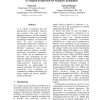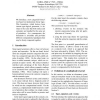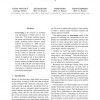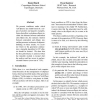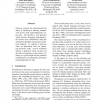ACL
2003
14 years 27 days ago
2003
We present a supervised machine learning algorithm for metonymy resolution, which exploits the similarity between examples of conventional metonymy. We show that syntactic head-mo...
ACL
2001
14 years 27 days ago
2001
It is widely recognized that the proliferation of annotation schemes runs counter to the need to re-use language resources, and that standards for linguistic annotation are becomi...
ACL
2001
14 years 27 days ago
2001
In this paper we address the problem of extracting key pieces of information from voicemail messages, such as the identity and phone number of the caller. This task differs from t...
ACL
2003
14 years 27 days ago
2003
A central problem of word sense disambiguation (WSD) is the lack of manually sense-tagged data required for supervised learning. In this paper, we evaluate an approach to automati...
ACL
2001
14 years 27 days ago
2001
ACL
2003
14 years 27 days ago
2003
Truecasing is the process of restoring case information to badly-cased or noncased text. This paper explores truecasing issues and proposes a statistical, language modeling based ...
ACL
2001
14 years 27 days ago
2001
This paper describes automatic techniques for mapping 9611 entries in a database of English verbs to WordNet senses. The verbs were initially grouped into 491 classes based on syn...
ACL
2003
14 years 27 days ago
2003
We train a decision tree inducer (CART) and a memory-based classifier (MBL) on predicting prosodic pitch accents and breaks in Dutch text, on the basis of shallow, easy-to-comput...
ACL
2001
14 years 27 days ago
2001
We present conditions under which verb phrases are elided based on a corpus of positive and negative examples. Factor that affect verb phrase ellipsis include: the distance betwee...
ACL
2003
14 years 27 days ago
2003
Previous research has demonstrated the utility of clustering in inducing semantic verb classes from undisambiguated corpus data. We describe a new approach which involves clusteri...

